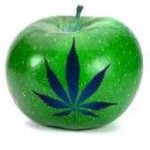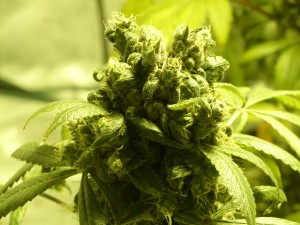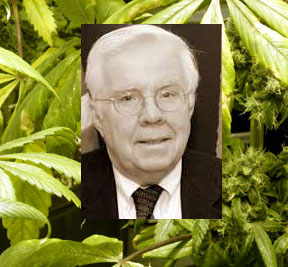 6/29/2011 – Pennsylvania recently passed a law banning some synthetic cannabinoids and New Jersey has pending legislation. These new prohibitions are intended to curb to the use of fad drugs that are sold under hundreds of brand names but commonly referred to as “K2” or “Spice.” Users seek a high with the ability to pass a standard drug screen.
6/29/2011 – Pennsylvania recently passed a law banning some synthetic cannabinoids and New Jersey has pending legislation. These new prohibitions are intended to curb to the use of fad drugs that are sold under hundreds of brand names but commonly referred to as “K2” or “Spice.” Users seek a high with the ability to pass a standard drug screen.
Earlier this year the federal Drug Enforcement Administration (DEA) permanently prohibited six synthetic cannabinoids, including a common Spice ingredient JWH-018.
Dozens of chemicals, including some synthetic cannabinoids, are found in the products. The chemicals are sprayed on random plant material (never real marijuana) and packaged as fragrant, mood affecting incense.
Wholesale K2 suppliers have purchased advertising on websites and in magazines (even setting up booths at trade shows) that target natural marijuana consumers. But, compared to the ubiquitous market for natural cannabis these synthetics were fairly uncommon…until states started banning them.
In a predictable irony, K2 sellers have benefited greatly from the effort to ban their products. Massive advertising campaigns have appeared on billboards, in print and on television that are funded by drug prevention groups and even tax dollars. The awareness efforts have skyrocketed the drugs out of obscurity and successfully made them a household name.
Part of the problem is that prohibitionists have mislabeled the K2 fad drugs as “synthetic marijuana.” But now authorities are finding that K2 manufacturers have altered their recipe. New K2 products have ingredients that are not technically illegal. This makes the bans fully ineffective and the products continue to be sold in retail stores and online.
Another shift for the issue is that a Willow Grove, Pa. based company started marketing urine tests for synthetic cannabinoids this year. But these tests are not widely available.
Freedomisgreen.com Editor Chris Goldstein and Science Editor Jahan Marcu have been covering the K2 story since late 2009. Below is an interview that was originally published at www.celebstoner.com
Jahan Marcu is one of the few cannabinoid scientists in America. He also serves on the medical advisory board of the national medical marijuana advocacy group Americans for Safe Access.
Marcu is uniquely familiar with both natural marijuana cannabinoids and these new synthetics. He published a landmark research paper proving the anti-cancer properties of THC and is considered one of the top experts in this field. I sat down with Marcu to discuss this strange new trend of people smoking laboratory chemicals.
As someone who is familiar with JWH-018 and these other synthetic cannabinoids in the lab, what is it like to see these things on the streets?
Think about the guys who invented JWH-018. This is probably the worst nightmare imaginable for a researcher to have the product of their hard work for many years, decades maybe, turned into a designer drug of abuse. Because then it gets banned and essentially your chapter in research history is over because your access to the drug vanishes. If they go systematically down the list banning all of the JWH compounds, those are less compounds we can use to enhance our knowledge of how the endo-cannabinoid system works.
What do you think of the recent bans of K2 and Spice products?
Well, I’m not a politician. I’m not a legislator and I’m not in law enforcement. And they need to do what they think is necessary to protect people. As some who’s in research and education my idea would be: Well, let’s see how dangerous these compounds are. Let’s go ahead and fund a bunch of small studies in animals. Let’s have some people who are already taking these drugs volunteer for some tests. Then we can look at them with side-by-side comparisons with alcohol and marijuana for impairment, and really get a good risk assessment. But that’s not going to happen,. There’s just going to be bans and an absence of knowledge.
From the stand point of a cannabinoid researcher, are these synthetic cannabinoid compounds something that humans should be smoking?
I would go with: No. The main reason is the animal data that is coming back is not that promising. There are a lot of JWH compounds and JWH is unique; it’s very potent at low doses. What is a little scary is that around 10 mg per kilogram in rats there was some decreased breathing. We’re talking about 1 milligram per kilogram that was able to cause catalepsy in mice.
This may indicate some off-target effects. What I mean by that is some interaction with the opioid receptors or something else. We’re seeing decreased breathing rates in rats and sort of respiratory depression from these compounds that strongly suggests that those effects are not mediated through the cannabinoid receptor system.
I have seen some rumors of people seeking the benefits of medical marijuana turning to these synthetic compounds so they can beat their workplace drug tests. Would they have any medical benefit?
At least when you’re going to whole plant cannabis, you can look to the scientific literature and know what you’re getting. There are over 500 compounds in the cannabis plant, but we know what they are. We even know what happens when it burns. No one has done those kinds of studies on Spice. No one has hooked up a Spice cigarette to a gas chromatograph and analyzed the smoke. Those studies have been done with tobacco and marijuana for decades. We have a wealth of information about whole plant marijuana. So you know way more what you are getting into when you use a drug like cannabis.
What’s up with the new urine test for K2?
The game might be over for some of the K2 and Spice compounds. The original research article on the metabolite in Spice – what the body does with them – was published by a group in Moscow. Basically, since only a small amount of the drug is needed to produce an effect, the levels of detection must be very sensitive in order to find these JWH-018 metabolites.
The structure of JWH-018 and (natural) THC is very different. If you looked at the two compounds side-by-side you would not have to be a chemist to see that they look vastly different. The unique part of JWH is the indol ring: It’s a two-ring structure with one nitrogen; this is a common motif found in other hallucinogens like LSD, mescaline and psilocybin, but is not found in (natural) THC.
Researchers have found that the body modifies the indol ring in JWH-018 and thus have developed the drug test around that modification. I’m not sure if it’s the same thing I saw marketed in California, but that is what is in the literature right now.
Do you think these will be effective tests or because of the detection levels someone will have to smoke a lot of this stuff to show up?
You’d have to be smoking a fair amount of Spice to be found in a urinalysis. It’s unclear right now because those studies just haven’t been done yet.
How is the lab community dealing with this K2/Spice phenomenon?
It definitely puts a time crunch on things. These compounds are very important to research. It would be a great loss to the scientific community if these compounds were no longer available for research. It’s a shame that unscrupulous business practices are ruining this for the scientists.
In the end, because there is no real labeling of these products, the most dangerous things in Spice may not be the chemicals we actually know about, but what we don’t. Some have been found to have synthetic opiates, Vitamin E and even acetone.
The continued prohibition of natural marijuana seems to be the only driving force behind the emergence of these new synthetic drugs. States that have decriminalized marijuana seem to have less of an issue with the fad drugs.
To advocates, this is an additional and rather poignant public safety reason for natural marijuana to be fully legalized, right now.
Celebstoner.com: The Truth About Spice & K2
Examiner.com: Facts about new synthetic drugs K2 or Spice
Jahan Marcu’s blog
Chris Goldstein is a respected marijuana reform advocate. As a writer and radio broadcaster he has been covering cannabis news for over a decade. Questions? [email protected]







